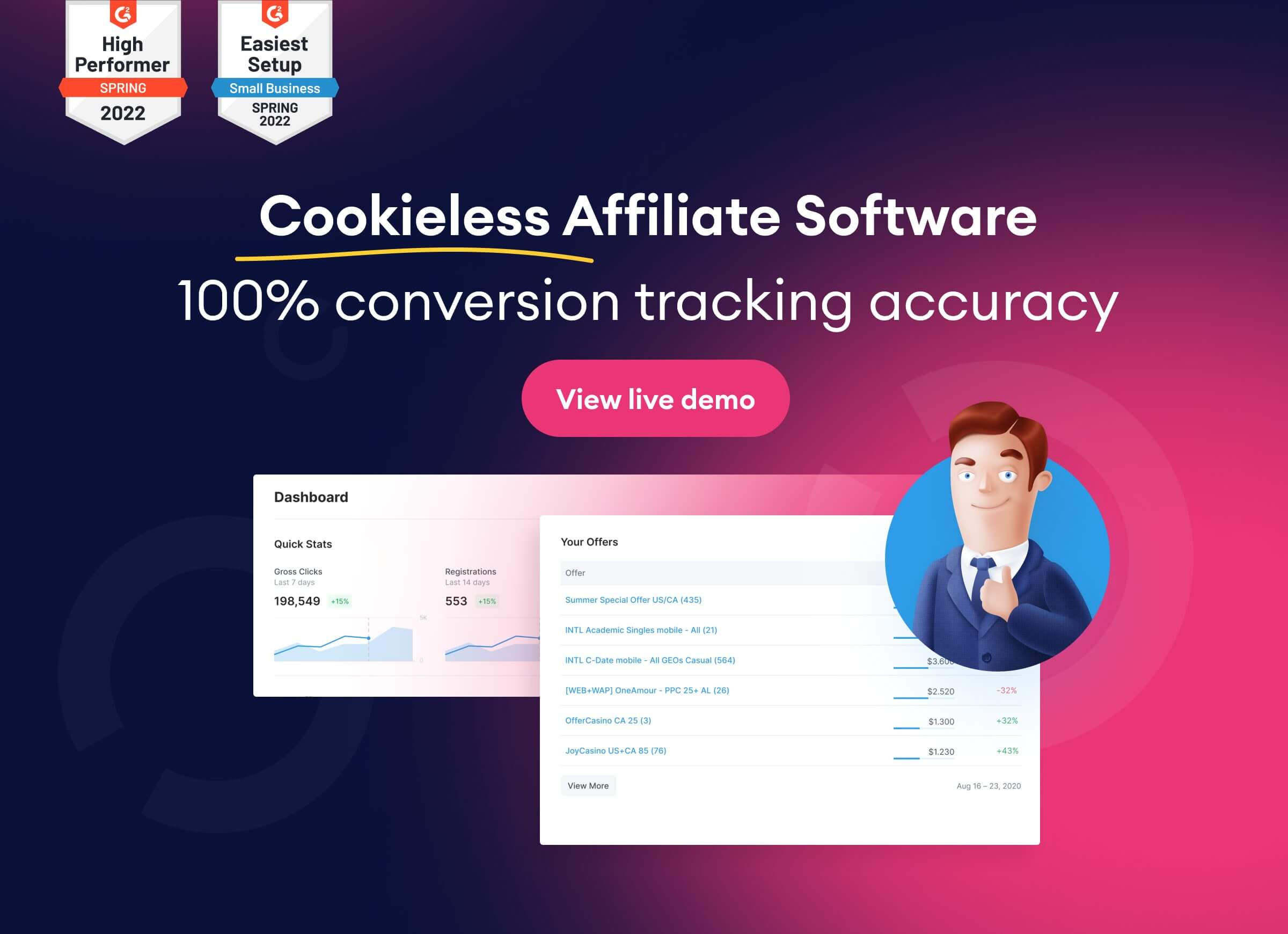Cookieless future – we dreaded it for years and now it’s finally here to stay. After Apple’s decision to restrict 3rd party cookies, which we have already covered in this and this post, the affiliate marketing industry began to shift towards cookieless solutions, offering a much more flexible way to track advertising and campaigns across platforms and devices.
Today, we are going to discuss the cookieless future, or, perhaps a more accurate term would be – “cookieless reality” in 2022. What difficulties do affiliate marketers face, what are the upsides of cookieless tracking and how to make the most off them.
For more than a year, publishers, businesses, and advertisers have awaited eliminating third-party tracking cookies. The elimination of this ubiquitous surveillance technology, first promised in 2020 and then postponed, could improve consumer privacy while upending the economics of digital ad targeting, which has made ad-supported content sustainable on the open Internet for many years.
Local advertisers and media companies will face particular hurdles from cookie devaluation, but they need not despair. The truth is that cookie-based targeting may not have been as effective as most would have us believe. Solutions now exist to help marketers of all sizes reach the right customers to grow their business without using third-party cookies.
What are Cookies?
Cookies are tiny text files that a website delivers to the browser when users visit the site.
The idea is to save crucial information and improve your browsing experience. They are utilized on most websites and are now a typical technique for browsing the Internet.
For a set length of time, cookies store the user’s access history to pages and programs, as well as their interactions (clicks, forms, passwords, and so on).

As a result, whenever the user returns to the website that gave the cookies, the browser sends the data back so that the pages load faster, already holding the visitor’s preferences and past data.
This enables the website, for example, to keep the user logged in or to remember the things they left in their shopping cart.
In addition to improving website visits, Cookies help improve Digital Marketing tactics by personalizing the experience and tailoring content to each user’s interests and habits.
Why are Cookies so Important?
Cookies can be used for a variety of purposes.
Despite the debate over data privacy, cookies are not the enemy. The issue is how they are used, which we will discuss later.
For the time being, let us look at what it is about cookies that make them so significant for the Internet and digital marketing.
In general, cookies improve users’ web experiences and tailor the content and advertisements they see to their preferences.
To further understand how this occurs, let’s look at the many sorts of cookies that a website might gather.
There are various classifications, but the following parts define the most frequent classes used by websites.
Cookies: Are they what we had expected?
The efficacy of cookie-based ad targeting has never been determined by fundamental efficiency but rather by the sheer scale that technology and big data can bring across millions of interactions.
Because local-market advertisers and media firms rarely use that degree of the scale, cookie depreciation may be less disruptive for them than for the 60% of US marketers who feel they will need multiple identification solutions to survive in a post-cookie era.
The alternatives being developed to replace cookies hold great promise and will most likely outperform cookies in terms of efficacy for local-market digital advertisers. Publishers with authenticated audiences can enable scalable people-based campaigns outside of walled gardens, and advertisers and publishers will benefit from more direct ties with their new and existing consumers.
Cookieless marketing refers to a style of marketing in which marketers rely less on third-party cookies, which are little bits of data shared between advertisers that contain personal identifiers when customers surf the web. This significantly impacts websites that use third-party cookies to identify customers and target them with relevant advertising or marketing.
Cookies, in general, store information about your computer in order to identify you as a unique visitor by storing unique identifiers such as registration numbers or session IDs. When cookies are removed, other identifiers (such as your IP address) will uniquely identify your computer to learn more about who you are online.
In a nutshell, cookieless websites store your data using other methods such as IP addresses or device IDs as identifiers rather than cookies. These new tactics will now follow you online. Google said in 2021 that it would no longer gather Personally Identifiable Information (PII) graphs from alternative identifiers such as users’ email addresses.
While the loss of third-party cookies may still have a significant impact on marketers who rely on analytics data (such as session IDs) to target ads, Google has opted out of PII collection methods in favor of what appears to be a more secure alternative: Federated Learning of Cohorts (FLoC), also known as the Privacy Sandbox.
FLoC, according to Google, is a “privacy-first” and “interest-based” advertising system (AdTech). Instead of third-party cookies tracking a user’s web browsing activities, Google’s web browser, Chrome, will do so. Users will be assigned to an audience or “cohort” based on their habits. Advertisers will subsequently be able to target their adverts to these anonymous groups rather than individual individuals.
These are technical cookies that are required for a website to function properly. Without them, the user cannot simply access the services and features of a website.
They aren’t used for marketing or communication:
- They can, for example, be used to identify that a user is logged into a website account.
- Remember prior information provided in internet forms.
- Ensure that users’ authentication is secure.
Functionality versus functionality Cookies is crucial because they provide a more personalized experience on the website based on the user’s previously stated settings.
They can be used, for example, to:
- Remember your language settings, font size, layout, and so forth.
- Remember whether the user has already indicated whether or not they want to participate in a survey.
Performance cookies are used to collect information about website traffic and visitor characteristics.
They are the data that Google Analytics collects, for example, to understand better how people interact with the website, such as which pages they visit and which links they click on, among other things.
It is critical to understand that performance cookies do not identify specific users.
The website administrator can only see how many people visited a page, not that James went to the Sports page and clicked on the volleyball news.
As a result, performance cookies are critical for brands that wish to:
- Analyze the performance data of your website and Digital Marketing.
- Improve their brand tactics by getting to know their target audience better.
- Examine the website’s communication efficiency.
- Identify flaws in pages to improve the user experience.
Advertising campaigns make use of targeting cookies.
They are used: based on user navigation and activity data
- Segment a more precise target audience for online advertising campaigns.
- Deliver ads that are aligned to the user’s profile and interests.

Users can also block this type of cookie, but they will still view advertisements on websites. The only difference is that they may view adverts that are unrelated to their profile.
The “Cookieless Future” is Bright and Grim
When all of the useless and destructive items built on 3P cookies are removed, the associated costs decrease, and the beneficial business outcomes from digital marketing increase. More specifically, when advertisers buy advertising from actual publishers with real human audiences, they will obtain better results than hyper-focused ads broadcast to bots pretending to be different audiences on millions of long-tail sites. This reduces the need for privacy-invading data collecting as well as the additional costs of targeting parameters, audience segments, fraud detection, brand safety detection, and so on.
The “cookieless future” seems promising for advertising, good publishers, and consumers. However, the future will be bleak for ad tech suppliers who have profited from intrusive data collecting from users, diverting ad income away from decent publishers, and peddling snake oil to advertisers.
Cookieless future – what’s ahead of us?
Advertisers and publishers across the ecosystem are set to be thrown back into the world of first principles advertising through tried-and-true approaches like contextual targeting. The concept of ensuring that adverts display next to context-appropriate material has been out of favor for a while, but it will be one of the most successful audience segmentation methods in a post-cookie era.
Furthermore, advertising has regarded its customers as an abstract field of data points devoid of genuine humanity for far too long. Performance marketers, particularly those who have historically relied on direct correlations between advertising spend and conversions, will likely struggle to shift to a world with less concrete attribution data.
Local-market marketers and media organizations will require technology’s assistance to make the narrow margins on their advertising buy economically reasonable because they lack the huge pools of data and experience that their national competitors do. Using local-market experience to assist run complex campaigns and workflow automation software in making labor-intensive operations more efficient.
In the end, firms that deliberately harness their greatest resources and maximize the value of their data and relationships will thrive in the post-cookie advertising future. Advertisers and publishers may prepare for the post-cookie world by expecting it now.
Cost Savings and Better Outcomes
In addition to the cost savings from eliminating fraud and brand safety detection vendors (which do not work), eliminating 3P cookies provides advertisers with a once-in-a-lifetime opportunity to undo the bad digital marketing habits of the previous decade without paying for the snake oil sold to them by ad tech vendors.
3P cookies misled advertisers into believing that more targeting equals more relevant ads and better economic outcomes. But, despite all of the promises from ad tech companies about how wonderful targeting would be, nothing occurred when big businesses turned off or halted their digital ad expenditure.
Chase received no better results from putting advertisements on 400,000 websites than from showing ads on 5,000 websites (99% less). Perhaps there weren’t many humans on those 395,000 other sites, and perhaps the ad targeting wasn’t all it was built up to be. Perhaps the great majority of “users” on the vast majority of long-tail sites were bots; such sites had few to no actual visitors, so they bought all of their traffic. Perhaps inferred audience segment targeting was worse than no targeting at all.
Ad Fraud
Eliminating 3P cookies will not boost ad fraud. This is because ad fraud is already widespread and significantly underreported by fraud detection businesses. Furthermore, fraud detection tech companies that rely on 3P cookies to accomplish their job have already lost. These fraud detection companies rely on cookies to identify previously discovered bots; when they see the same cookie, they know it’s a bot.
The issue with this strategy is that bots discard cookies and obtain fresh ones in the same way that people clear cookies from their browsers. If the bot detection tech provider hasn’t seen a certain cookie before, they let it through, allowing the bots to pass. These fraud detection technology vendors are completely ineffective at detecting IVT. Advertisers that spent millions of dollars for these services did not receive what they paid for and should sue these vendors for selling them things they did not receive.
Furthermore, 3P cookies allow bots to impersonate any audience segment that advertisers choose to purchase for ad targeting purposes. Bots, for example, will purposefully visit a variety of medical sites in order to look to be doctors; this allows them to earn higher CPMs from pharma businesses that pay more to target specialized audiences. Bots can also write search terms or add things to the basket and then leave them in order to fool search and cart abandonment retargeting algorithms and make more money. Eliminating 3P cookies minimizes these specific fraud routes, resulting in less money wasted on fraud. Isn’t that counter-intuitive?
Privacy
Google and Apple’s actions improve consumer privacy. After years of ad tech businesses collecting data on consumers without their awareness, consent, or redress, that’s a good thing. All of the ad tech businesses are claiming that Google and Apple are abusing their monopoly capabilities.
That is correct.
However, no other entity could compel the necessary modifications to increase consumer privacy. This boost in privacy is still relative because Google still has a lot of data on users who are continually signed into free services like Gmail, YouTube, Android devices, and so on. Apple also knows a lot about its users.
Changing the focus, staying on Topic
We must abandon our search for a replacement for the granular targeted solutions we have been accustomed to. Targeting granularity and nature will inevitably evolve in the next years. But we must not lose sight of the need for technologies that enable us to target addressable audiences on a large scale.
It’s time to shift our collective focus and address the populations that advertising is already overlooking.
With the cookieless age on the horizon – and it’s already here on Safari and Firefox – most media planners and buyers are now losing 45% of the addressable scale they previously had access to. Even with introducing new targeting solutions like Topics, we anticipate that more than one-third of the market will remain unaddressable using current methods like Topics and unified identifiers.
Conclusion
It may not seem urgent, but planners should be thinking about this suddenly unreachable population and what they can do to re-engage these previously unaddressed audiences.
Attention to data protection and transparency in relations with consumers is a path of no return.
Every day, the Internet permeates more areas of our lives. This means that increasingly sensitive data is being collected.
The cookieless future of digital marketing is fast approaching, and your business needs to be ready for it. Start thinking now about corporate data handling and marketing strategies that respect user privacy.
Last Updated on April 10, 2024




